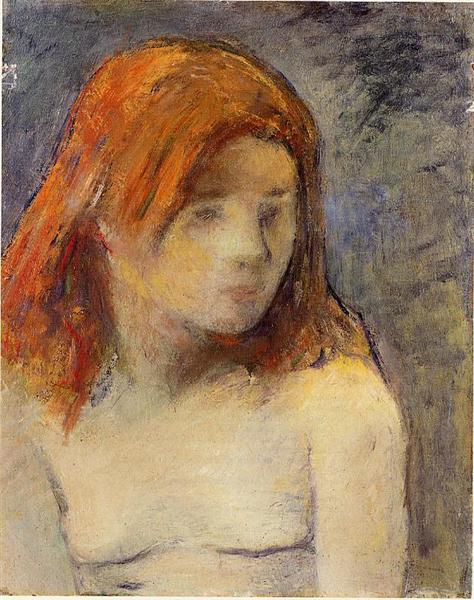Description
The work "Bust of a naked girl" (1884) by Paul Gauguin is an eloquent example of the artist's transition to a pictorial language that would capture the essence of a radical and deeply personal aesthetic vision. Painted at a time when Gauguin moved away from the strictly realistic representation of academic art, this work stands out for its bold treatment of the human figure and its innovative approach to color.
In this painting, the young woman shows in a portrait that focuses on her bust. The figure is presented with a serene posture and a face that evokes a mixture of innocence and contemplation. His skin, treated with a warm tone, stands out against a colder and more dark background, suggesting an intriguing contrast that guides the viewer's gaze towards the absence of costumes and the essentials of his being. This approach in nude, far from being merely provocative, seems to look for a connection with the primary, a recurring theme in Gauguin's work, who often explored the relationship between humanity and nature.
The composition is remarkable for its simplicity and elegance. Gauguin uses soft and clean lines that model the shape of the body with grace. Instead of the complex anatomical details that characterize other styles, the artist opts for a simplification that suggests the way without defining it rigidly. This technique is aligned with the principles of post -impressionism, where subjectivity and personal expression are key. The soft curve of the shoulder line and the neck contour illustrate their ability to raise the ordinary to the extraordinary, a distinctive feature of its style that continues to resonate in modern art.
The color also plays a critical role in the work. Gauguin is known for its bold color use, and in "bust of a naked girl" this technique becomes a vehicle for emotion. The dark background allows the figure to shine with a slight touch of lighting that seems to emanate from itself, thus suggesting an almost ethereal quality. This use of color is a precursor to the symbolism that Gauguin would develop in his subsequent works, where colors are not merely representative, but have emotional and poetic meanings.
Through this work, Gauguin can also be referring to a broader search for authenticity in the female figure. As the nineteenth century progressed, women's representations in art were often molded by the social and cultural restrictions of the time. However, in the case of this painting, the woman is represented without ornaments or idealizations, which could be interpreted as an affirmation of her humanity and a return to the essential.
"Bust of a naked girl" can be seen as a prelude to the most complex explorations that Gauguin would carry out in Tahiti, where interest in non -western cultures and the most elementary life would form a new chapter in his career. Ultimately, this work is not only located in the context of Gauguin's personal development as an artist, but also puts the notion of the portrait to an exploration of the human soul, which continues to captivate the contemporary spectator. Although it is an intimate portrait, it evokes a universality that resonates beyond time and space, allowing the "naked girl" to speak for each contemplation.
KUADROS ©, a famous paint on your wall.
Hand-made oil painting reproductions, with the quality of professional artists and the distinctive seal of KUADROS ©.
Reproduction service paintings With a guarantee of satisfaction. If you are not completely satisfied with the replica of your painting, we refund your money 100%.

